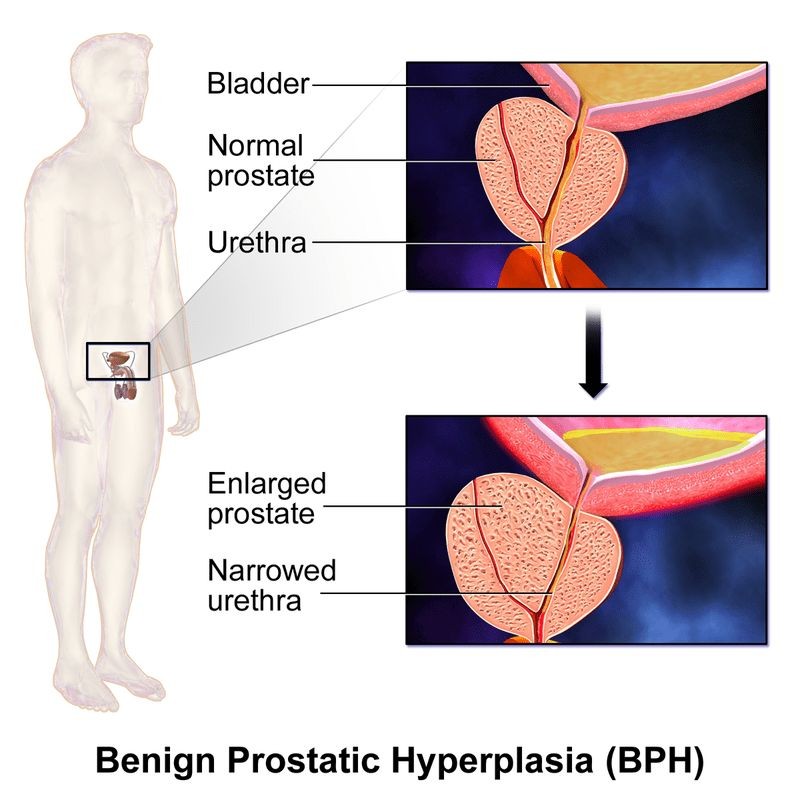
Contents
- 1 Prostatitis vs. BPH (Enlarged Prostate): What Is the Difference?
- 1.0.1 Are prostatitis and BPH the same?
- 1.0.2 Do prostatitis and BPH cause pain?
- 1.0.3 How can I tell the difference between prostatitis and BPH symptoms?
- 1.0.4 What causes prostatitis vs. BPH?
- 1.0.5 Where is the prostate gland located and what does it look like?
- 1.0.6 How are prostate problems diagnosed?
- 1.0.7 Are the treatments for prostatitis and BPH different?
- 1.0.8 What is the prognosis of BPH and prostatitis?
- 1.0.9 From
Prostatitis vs. BPH (Enlarged Prostate): What Is the Difference?
The definition of prostatitis is inflammation of the prostate tissue. Causes can be infection or other health problems.
What is BPH (enlarged prostate)?
Most men over 50 have some prostate enlargement due to the proliferation of prostate gland cells. Most men have BPH or benign prostatic hyperplasia, even without symptoms. This gland enlargement is noncancerous and termed benign prostatic hypertrophy or BPH. There is only one type of BPH, "benign," meaning non-cancerous or not malignant.
Are prostatitis and BPH the same?
Both may have similar health symptoms, but each problem has different causes. BPH is an enlarged prostate, but it’s not caused by infection/inflammation like prostatitis. However, not all enlarged prostates are due to BPH. An enlarged prostate may be caused by BPH, prostatitis, and prostate cancer.
Do prostatitis and BPH cause pain?
Both may cause pain. If BPH causes pain, it usually occurs with urination. Prostatitis may cause painful urination, ejaculation, and groin/abdominal pain. Prostatitis pain may be constant and due to inflammation of the prostate tissue and/or adjacent tissues. The source of pain from prostatitis is often unclear.
IMAGES
How can I tell the difference between prostatitis and BPH symptoms?
If you don’t have symptoms, a doctor can detect prostate enlargement with a rectal exam. If you have symptoms, they are related to the increase in prostate size and may include:
- Frequent urination
- Sudden urgent need to urinate
- Difficulty initiating urinary stream
- Feeling like you still need to urinate after recent urination
- Feeling the need to strain to empty bladder
- Decrease in force of urine stream
- Loss of small amounts of urine (dribbling)
Symptoms of prostatitis depend on the type.
Acute bacterial prostatitis (type I) symptoms
- Fever
- Chills
- Muscle soreness
- Joint discomfort
- Fatigue
- Prostatic discomfort and/or pain
- Painful urination
- Low back and/or abdominal pain
- Possible urethral discharge
- Urinary stream problems
Chronic bacterial prostatitis (type II) symptoms
- Intermittent painful urination
- Intermittent obstructive urinary tract symptoms
- Recurrent urinary tract infections
Chronic prostatitis and chronic pelvic pain syndrome (type III) symptoms
- Pelvic pain and/or discomfort
- Obstructive urinary tract symptoms
- Pain with ejaculation
- Erectile dysfunction (ED)
Asymptomatic inflammatory prostatitis (type IV) symptoms
- By definition, type IV has no symptoms, but sometimes diagnosed from a prostate biopsy or suspected when PSA blood test is elevated.
Some men may have these symptoms with both BPH and prostatitis. If you’re over 50, it’s likely BPH. If you’re under 35, acute bacterial prostatitis is more likely. Prostatitis may be recurrent.
What causes prostatitis vs. BPH?
The cause of BPH or enlarged prostate is a benign growth that enlarges the prostate gland. Researchers do not know exactly what causes the enlargement, but hormonal changes as men age may be a factor.
In men under 35, the most common type of prostatitis is acute bacterial prostatitis, while non-bacterial prostatitis is most common in older patients. There are four types or syndromes of prostatitis.
- Type I – Acute bacterial prostatitis
- Type II – Chronic bacterial prostatitis
- Type III – Chronic prostatitis and chronic pelvic pain syndrome
- Type IV – Asymptomatic inflammatory prostatitis
The cause of acute bacterial prostatitis is bacteria that may be present in the urethra and then infect the prostate gland. Chronic bacterial prostatitis occurs due to inadequate treatment or structural/functional problems in the urinary tract. The cause of chronic prostatitis is not completely understood but may be related to neurological injury and/or infection.
Where is the prostate gland located and what does it look like?
Picture and Location of the Prostate Gland
How are prostate problems diagnosed?
See your primary care doctor for a complete history and physical exam, including a rectal exam. Diagnostic tests may include urinalysis, urine culture, blood tests (such as PSA test), and other tests like ultrasound, endoscopy, urine flow rate studies, and prostate biopsy.
Your doctor may refer you to a urologist, especially if surgery is needed.
By clicking "Submit," I agree to the MedicineNet Terms and Conditions and Privacy Policy. I also agree to receive emails from MedicineNet and I understand that I may opt out of MedicineNet subscriptions at any time.
Are the treatments for prostatitis and BPH different?
Treatments for an enlarged prostate and prostatitis are different.
BPH treatment may include an interactive questionnaire to assess symptoms. Medications and other treatments may be recommended based on the questionnaire results. Treatment options for BPH include alpha receptor blockers, phosphodiesterase inhibitors, and anticholinergic agents. Some patients may require surgery to reduce pressure on the urethra.
Treatment for prostatitis depends on the type.
- Acute and chronic bacterial prostatitis (type I and II) are typically treated with antibiotics like fluoroquinolones or trimethoprim. Treatment may last 4-8 weeks. In some cases, antibiotics may need to be injected directly into the gland.
- Chronic bacterial prostatitis and pelvic pain syndrome (type III) are treated with antibiotics, alpha-blockers, and NSAIDs like aspirin and ibuprofen.
- Asymptomatic inflammatory prostatitis (type IV) usually requires no treatment, but antibiotics and NSAIDs may be prescribed.
What is the prognosis of BPH and prostatitis?
The prognosis for BPH is good to fair with treatment. Complications may occur with surgery, such as erectile dysfunction. Prostatitis can have significant symptom relief with treatment. Recurrent bouts of prostatitis are possible.


